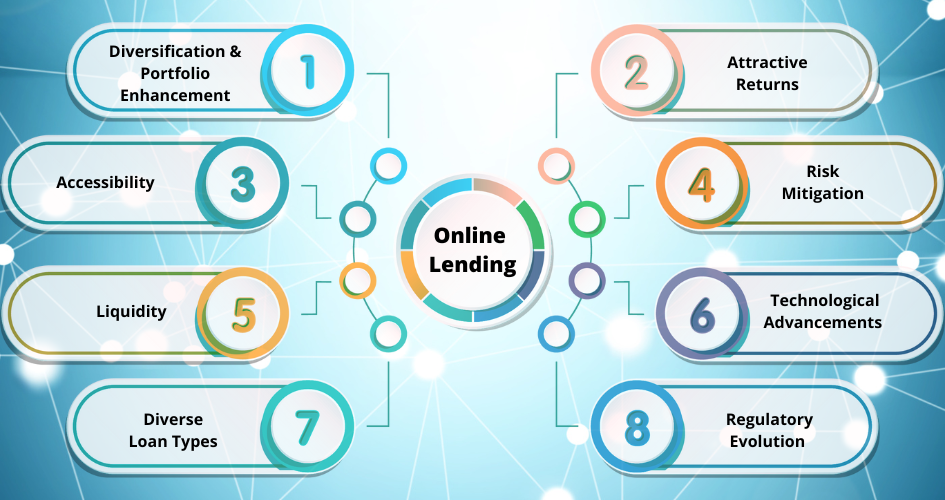
Introduction
In the rapidly evolving finance and investment landscape, online lending has emerged as a leading asset class, attracting individual and institutional investors. With the expansion of technology and the internet, lending has transitioned from traditional banks to online platforms, offering investors an array of opportunities and benefits. This article is all-encompassing and covers various aspects of the subject matter. We will explore why online lending has gained prominence and is considered a leading asset class.
Understanding Online Lending
Online or peer-to-peer (P2P) lending or marketplace lending is a financial practice that connects borrowers with individual or institutional lenders through online platforms. These platforms use advanced algorithms and data analytics to assess the creditworthiness of borrowers and match them with lenders willing to fund their loans. This model bypasses traditional banks and financial intermediaries, directly linking borrowers and lenders.

Why Online Lending is Becoming the Leading Asset Class
Online lending provides investors with an opportunity to diversify their portfolios. Traditionally, portfolios consisted of stocks, bonds, and real estate. However, online lending offers an additional asset class that can reduce a portfolio’s overall risk. Diversification is a fundamental principle of investment, and including loans in a portfolio can help mitigate risks associated with market volatility.
One of the primary reasons online lending has gained popularity among investors is the potential for attractive returns. Online lending platforms often offer higher interest rates than traditional savings accounts and other fixed-income investments. Depending on the type of loans and the platform, investors can earn substantial returns, which can be particularly appealing in a low-yield environment.
Investing in online lending is accessible to a wide range of investors. Unlike traditional investments that require substantial capital or accreditation, many online lending platforms allow individuals to start with relatively small amounts of money. This democratization of finance means that a broader spectrum of investors can participate and potentially benefit from this asset class.
Online lending platforms utilize sophisticated underwriting models and risk assessment tools to evaluate borrowers. While there are risks associated with lending, these platforms aim to minimize them by assigning risk grades to borrowers and providing investors with information to make informed decisions. Additionally, investors can diversify their investments across multiple loans to mitigate individual loan default risks.
Online lending offers varying levels of liquidity, depending on the platform and the type of loans chosen. Investors can sell their loan notes to others on some platforms that offer secondary markets. It allows investors to exit their investments before the loan term expires, offering a degree of liquidity that traditional fixed-income investments may lack.
Advancements in technology have greatly facilitated online lending. Machine learning, AI (Artificial Intelligence), and big data analytics accurately assess borrower risk. These technologies also enhance the user experience for borrowers and lenders, making online lending an attractive option in the digital age.
Online lending platforms offer various loan types, from personal and small business loans to real estate and consumer credit. This diversity allows investors to customize their portfolios based on risk tolerance and objectives, making online lending more appealing.
The regulatory environment for online lending has evolved to provide more oversight and consumer protection. As the industry matures, regulatory bodies increasingly recognize and regulate online lending platforms, enhancing transparency and security for borrowers and investors.
Challenges and Risks in Online Lending: A Detailed Analysis
While online lending presents lucrative opportunities for investors, it is vital to acknowledge the challenges and risks of this asset class. Understanding these risks is crucial for making informed investment decisions. Below, we delve into the challenges and risks of online lending in detail:
a. Borrower Default: Borrowers may fail to repay their loans, leading to potential investor losses. Default risk is inherent in lending, and it is particularly relevant in online lending, where borrowers may have varying creditworthiness.
b. Credit Risk: Investors in online lending are exposed to significant credit risk, which means that borrowers may default on their loans. While platforms employ advanced underwriting algorithms to assess creditworthiness, there is no guarantee against defaults.
c. Economic Downturns: Economic recessions or downturns can significantly impact default rates. When economic conditions deteriorate, borrowers may experience financial hardships, making it more challenging to meet their repayment obligations.
a. Platform Viability: The stability and credibility of the online lending platform can significantly affect investor returns. Some platforms may struggle to attract borrowers or experience financial difficulties, potentially leading to losses for investors.
b. Operational Risk: Technical issues, cybersecurity threats, or operational failures on the platform can disrupt loan servicing and pose risks to investor returns. These risks underscore the importance of choosing a reputable and well-established platform.
c. Regulatory Changes: Changes in regulations can impact the operations of online lending platforms. Regulatory uncertainty or shifts can lead to compliance challenges for platforms and may affect the availability of specific loan types.
a. Interest Rate Risk: Online lending platforms often offer fixed-interest rate loans. Changes in broader interest rates can affect the attractiveness of these loans. For example, if interest rates rise significantly, the returns on fixed-rate loans may become less competitive than other investments.
b. Economic Factors: Economic conditions and market trends can influence borrower behaviour and loan performance. In a strong economy, default rates may be lower, but during economic downturns, defaults can increase, affecting investor returns.
a. Concentration Risk: If investors allocate a substantial portion of their portfolio to online lending, they may face concentration risk. Concentrating investments in a single asset class can increase exposure to its specific risks, potentially leading to more significant losses if problems arise.
b. Lack of Asset Variety: While online lending platforms offer various loan types, investors may still need more asset variety compared to traditional financial markets. This lack of diversity can make portfolios more vulnerable to specific market conditions.
a. Lock-In Periods: Many online lending platforms have lock-in periods where investors can only access their funds once loans mature. This lack of immediate liquidity can be problematic for investors, who may need to access their capital on short notice.
b. Secondary Markets: While some platforms offer secondary markets where investors can sell their loan notes, liquidity may still be limited, and investors may need to accept discounts to sell their investments before the loan term expires.
a. Regulatory Variability: The regulatory environment for online lending varies by jurisdiction and can change over time. It can create uncertainty for investors regarding the legal and regulatory framework governing their investments.
b. Compliance Challenges: Online lending platforms must adhere to evolving, complex regulations. Non-compliance or regulatory changes can disrupt platform operations and impact investor returns.
a. Limited Information: Investors rely on the information provided by the lending platforms to assess loan opportunities. There may be limited transparency, and investors may need access to all relevant borrower information, increasing the risk of investing in loans with hidden weaknesses.
Conclusion
Online lending has emerged as a leading asset class in the financial landscape due to its potential for attractive returns, diversification benefits, accessibility, and technological advancements. While it offers numerous advantages, investors should also be aware of the associated risks. As the industry continues to evolve and mature, online lending will play an increasingly significant role in individual and institutional investors’ portfolios, solidifying its status as a leading asset class in the digital era.
FAQs (Frequently Asked Questions)
While online lending platforms can be safe, they are not without risk. It is essential to research and choose reputable platforms, diversify your investment portfolio, and be aware of the potential for defaults.
Earnings from online lending can vary widely depending on the loans you choose, interest rates, and the platform’s performance. It is crucial to establish achievable expectations that are grounded in past performance.
Many platforms offer liquidity options, such as secondary markets, but the ability to withdraw funds may be subject to certain restrictions and terms. Read the platform’s terms and conditions carefully.
Online lending can be a suitable investment for retirees looking for passive income, but assessing risk tolerance and investment goals is crucial to ensure they align with their financial plan.
To get started, research online lending platforms, create an account, fund it, and begin selecting loans to invest in. Some platforms offer automated investment options for convenience.
How Can Datavision help?
We assist various financial institutions and global banks on their digital transformation journey. Our one-of-a-kind approach, which combines people, process, and technology, expedites the delivery of superior results to our clients and drives excellence. Several reputed companies leverage our proprietary suite of business excellence tools and services to unlock new growth levers and unparalleled ROI.
Datavision stands proudly as a prominent banking software solutions provider, recognized for our unwavering commitment to excellence in the industry. We have earned our esteemed reputation by consistently delivering cutting-edge core banking software, catering to the needs of both retail and corporate banking software sectors. At Datavision, our mission is clear: to provide our clients with the best banking software products, ensuring that they stay ahead in an ever-evolving financial landscape. We take pride in serving our prestigious clients and look forward to continuing our journey of innovation and excellence.
Our portfolio of banking software product and services include:
Core Banking Solutions: | FinNext Core | Banking: | FinTrade | EasyLoan | MicroFin |
Digital Banking Solutions: | IBanc | MobiBanc | MBranch | FinTab | FinSight |
Risk & Compliance: |FinTrust |
Want to know how our team of experts at Datavision provides customizable, scalable, and cost-effective banking software products and solutions to our esteemed clients? Visit us for more information.